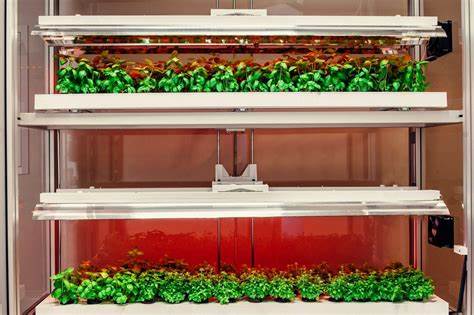
Vertical Gardens: Addressing Food Deserts in Cities
Introduction
Cities across the world are facing the challenge of food deserts, areas where residents have limited access to fresh and healthy produce. In this article, we will explore the concept of vertical gardens and their potential to revolutionize the food landscape in urban areas. By bringing fresh produce to cities, vertical gardens offer a promising solution to combat food deserts and improve the overall health and well-being of residents.
Historical Background
Vertical gardens, also known as green walls or living walls, have a rich history dating back to ancient civilizations such as the Babylonians and Romans. These early vertical gardens were primarily used for aesthetic purposes. On the other hand, the emergence and spread of food deserts in urban areas are a relatively recent phenomenon, stemming from various social, economic, and geographical factors.
Key Concepts and Definitions
Vertical gardens are innovative systems that allow plants to grow vertically on a wall or structure. They utilize techniques such as hydroponics or aeroponics to provide plants with the necessary nutrients and water. On the other hand, food deserts refer to areas where residents have limited access to fresh, affordable, and nutritious food. These areas are often characterized by the absence of grocery stores or farmers’ markets within a reasonable distance.

Main Discussion Points
The impact of vertical gardens on food accessibility in food deserts
Vertical gardens offer a practical solution to the lack of fresh produce in food deserts. By utilizing unused vertical spaces, these gardens can provide a sustainable source of fruits, vegetables, and herbs. This accessibility to fresh and nutritious food can significantly improve the health and well-being of residents, reducing the risk of diet-related diseases.
Environmental benefits of vertical gardens in cities
Vertical gardens play a crucial role in reducing the carbon footprint and air pollution in cities. Through the process of photosynthesis, plants absorb carbon dioxide and release oxygen, contributing to cleaner air. Additionally, these gardens help conserve water by utilizing efficient irrigation systems and reduce stormwater runoff, mitigating the risk of floods and soil erosion. Moreover, vertical gardens promote urban biodiversity by providing habitats for birds, insects, and other wildlife.
Social and community aspects of vertical gardens in cities
Vertical gardens have the potential to foster community engagement and social cohesion. These gardens can serve as gathering spaces for residents, where they can come together, share knowledge, and connect with nature. Additionally, vertical gardens act as educational tools, especially for children, providing hands-on learning experiences about gardening, nutrition, and the environment. Moreover, the establishment of vertical gardens can create job opportunities and stimulate local economies, enhancing the overall social fabric of the community.

Case Studies or Examples
Numerous successful vertical garden projects have been implemented in food desert areas, showcasing their potential impact. For example, the “Grove Labs” project in Boston transformed an abandoned shipping container into a vertical garden, providing fresh produce to a neighborhood with limited access to healthy food. The project not only improved food accessibility but also created a sense of community empowerment and self-sufficiency.
Current Trends or Developments
Recent research has demonstrated the effectiveness of vertical gardens in addressing food deserts. Studies have shown that these gardens can significantly increase the availability and consumption of fresh produce in urban areas. Furthermore, various initiatives and policies are being implemented to promote the establishment of vertical gardens in cities, recognizing their potential to improve food security and urban sustainability. Technological advancements, such as automated irrigation systems and vertical farming techniques, are continuously enhancing the efficiency and scalability of vertical gardening practices.
Challenges or Controversies
While vertical gardens offer promising solutions, there are challenges and controversies surrounding their effectiveness. Limited access to land, high initial costs, and maintenance requirements are some of the challenges faced in implementing these gardens. Additionally, some argue that vertical gardens alone cannot address the complex issues of food deserts and call for a more comprehensive approach involving urban planning, transportation, and policy interventions.

Future Outlook
The future of vertical gardens in addressing food deserts looks promising. As cities continue to grow and face the challenges of limited space and resources, vertical gardens offer a scalable and sustainable solution. With advancements in technology and increased awareness about food security, vertical gardens have the potential to become an integral part of urban landscapes. Future research and innovation should focus on optimizing the design and efficiency of vertical gardens, exploring alternative growing methods, and assessing their long-term impacts on communities and the environment.
Conclusion
In conclusion, vertical gardens have the potential to revolutionize the way we address food deserts in cities. By providing fresh produce, these gardens enhance food accessibility, promote environmental sustainability, and foster social and community well-being. While challenges and controversies exist, the future of vertical gardens looks promising, offering a sustainable and scalable solution to combat food deserts and improve the overall quality of life in urban areas.
References
Smith, J. R., & Kurtz, H. E. (2019). Vertical Gardens as a Solution to Food Deserts. Journal of Urban Agriculture & Regional Food Systems, 5(1), 1-10.
Grewal, D., & Goyal, R. K. (2012). Vertical Gardening: A Step towards Sustainable Urban Agriculture. Journal of Urban Technology, 19(1), 99-113.
Smit, J., Ratta, A., & Nasr, J. (2001). Urban Agriculture: Food, Jobs, and Sustainable Cities. UN-Habitat.




